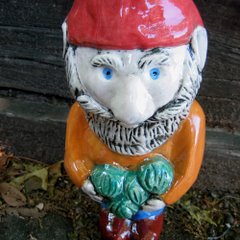Before I joined CCGW, I relied on myself, friends and family for critique. But is critique really that important? According to my college professors, yes. Of course, I didn't listen to a thing they said, so it wasn't until our president Devanie Schilpp dropped the "c" word a couple of times that it dawned on me: Critique is important for artists who would like to grow.
I can only speak for myself here, but for me it's a huge inspiration to see how the other artists in the studio evolve their work and refine their techniques. We all have our areas of expertise, our comfort zones where we can work with speed and produce items we like. Once I have established the boundaries of my comfort zone or my area of "expertise" (if you can call it that) the fun part is then coming up with variations. If I stay in my comfort zone, I get bored. I'm a pottery robot. If I deviate, I'm taking a risk. If I try too many new things at once, I lose track of what works and what doesn't. This is why critique is important to me, and has helped me grow as an artist.
It's not like we call a tribal critique where everyone shows up at the studio and sits in a circle and takes turns making comments about specific pieces. It just kind of happens, usually in a one-on-one conversation.
And this is how I learned that my photography skills had room for improvement. Dev, who happens to be a professional photographer in addition to being a clay and glass genius, suggested that the details in my pots would show up better if I could avoid backlighting.
Huh? What's backlighting?
When I joined etsy.com, I remember reading their pointers about the importance of having good photos when listing inventory on the internet. So I asked for a fancy digital camera for Christmas, and Santa came through. I never bothered to read the instruction manual. I just played with the buttons, and recognized some of the icons from my old 35mm camera that I used in my photography class back in college.
Thank heavens Devanie was kind enough to tweak my camera settings and school me on how to take good shots of my work. Here are the notes:
*Avoid backlighting. Natural light is a must. Use "open shade" or wait till a cloudy day. Avoid harsh light. Soft light is desired.
*If submitting to a gallery or festival, always use a solid white or 18% gray cardstock for the background. Set the item on top of the card, and fold the card so it comes up behind the piece as well. But don't crease it. It should just be a gentle curve. This way when you take the photo it will look like your piece is floating in white space, or gray space.
*Fill the entire frame with your item.
*Show the item from several different angles. Show the details. Show what makes this piece unique.
Having good quality photos of your work will come in handy for museum/gallery submissions, online portfolios, tax/insurance purposes, and of course, for your own personal benefit. What if your piece gets broken or lost? What if it sold 2 years ago and you forgot what it looks like? Then you have a photo to remember it by, in case you want to make a new one.
The most up to date information on Atlanta's non-profit artist cooperative. Typed by little gnomes.
Subscribe to:
Post Comments (Atom)

No comments:
Post a Comment